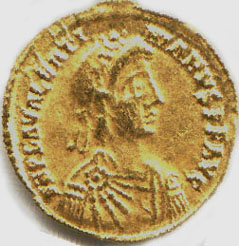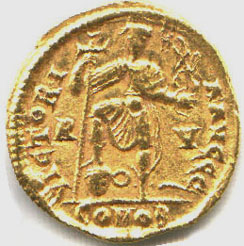Le Theatre des Miseres Angloises
Vn Dragon, de
sept Chefs, de Queüe monstrueuse
Et Deux Ailes fourny,
pour se nourrir de chair,
Du profond des enfers, par
Source caverneuse,
Difficile à boucher, à Londres rompe
en l'air.
La monstre bat soudain, et ses griffes imprime,
Luy abatant la Teste, au col du grand Strafford:
Et
u'a presque immolé l'Evesque, sa victime,
Ou regarde le
Roy, et hurle fier et fort.
l'Innocence s'estonne et abbaise
l'esprit:
Il l'assaille aussy-tost, et luy mord au
gosier.
Cruauté, se mocquant de Majesté sacrée,
Et
Couronne, luy va versant le sang si chere.
Le Ciel semble
attristé de ce fait execrable,
Dieu monstre son courroné
par foudres, la clairté
Du soleil se termit; le Ciel (chose
admirable!)
Se crevasse et enfante vn ost
tout-equipé.
Roy Charles le second oit ce tonnant
nuage,
Avec Dame Marie à Table, et voit pallier
De
l' Orenge la Rose, il eschape l'orage,
Le Droit de la
Courone empoignant, va choisir
Le sente des heros.
l''Escossois, mis en terre,
Luy renforce la gauche auec
leur Vltion
Irritée, l' Yrlande, accrüe dans la
guerre,
Les armes luy emboucle, et prisa sa
raison.
l'On vuit l' Harnois, serré au Corp Royal,
reluire,
Comme vn cristal poli, à l'aspect du soleil.
Le grand Dragon, embeu du sang de grand
martire,
En lion furieus, mugit au lac vermeil.
Nul
Basilic vomit tant de venin en terre,
Qu'icy, par tous ses
becqs, ce monstre plein d'effroy:
Mais le Prince heritier
des vertus de son Pere,
Passe oultre a ceste voix: Que
Dieu garde le Roy.
Que la Tamise, alors que l'Espée
Royale
Perce la cœur monstreux, fumera de
dépit!
Quels bruits s'iront bruillants à Withal en la
salle,
Quand la grand Majesté par son droit,
s'aggrandit!
The Theater of England's Miseries [from the French (tr. DK)]
A seven-headed dragon monstrous-tailed
with
brace of wings arrayed to feast on flesh
sprung from a
cavern in the depths of hell,
hard to repress, in London
bursts abroad.
The monster strikes apace and sinks his
claws
in the great Strafford's neck, strikes off his
head,
next all but immolates his bishop-victim,
faces
the king, and bellows fierce and loud.
Innocence is
thunderstruck and loses heart;
the beast forthwith attacking bites his throat.
Cruelty, derisive of his sacred highness
and crown, goes scattering his
precious blood.
Heaven looks saddened at this cursed
deed;
God shows his crowned by lightning; the sun
darkens,
and-wonder to relate!-the heavens
gestate
and bear an army fully armed for
battle.
King Charles the Second hears this storm of
thunder
with Lady Mary at table, and sees darting
the
flicker of storm's fire, but scapes the tempest;
his right to
crown inciting, he embraces
the hero's path. To reinforce
his left
the Scot, obeisant; with irate
revenge
matured by way of war, the Irishman
fits
him with arms, and he defends his reason.
On regal
limbs one sees the harness gleaming
like polished crystal
in the sun's bright luster.
The great Dragon, dyed in great
martyr's blood,
over the blood-bath roars like raging lion.
No basilisk on earth spews so much venom
as here
from all his maws this frightful monster;
but the prince
heir to all his father's virtues
goes over with these words;
"God save the King!"
How the Thames, once the regal
sword transpierces
the monstrous heart, will fume in
sheer despite!
What tumults will erupt in Whitehall's
chamber
when his great Highness ripens in his
birthright! |
Het Tooneel der Engelsche
Ellenden.
Een Grouwelycken Draeck, versien mit
seuen Koppen,
Twee Vleugels, en een Steert, zeer
zelzaem van fatsoen,
Quam yyt den afgront, door een
Wel niet wel te stoppen,
In' t Machtich Londen op, om
sich met vleesch, te vóen.
Het Monster sloech terstont de
klauwen van syn pooten
In Strafforts hals, en scheurd'het
Wyse hooft van't lyf
t'Had Bisschop Willems bloet noch
nauwelycx, vergoten.
Of't sach den Kouninck aen, en
brulde stout, en styf.
l'Onnooselheyt verschrickt', en liet
et Slach-sweert sincken,
Met schoot' et Monster toe, en
beet'em in de strot.
De Wreetheyt gaf aen t'dier het
dierbaer blot te trinken,
En dreef zoo, met de Croon en
t'Hooghgesagde spot.
Den Hemel scheen terstont, om dit
bedryf te treuren,
Godt blixemd' op' et slach en liet syn
gramschap sien,
De Son wiert peersch, en blauw. De
locht begon te scheuren,
En baerd', o wonder werck! een
leger Ys're lien
De Tweede Karel hoor' all dese
donderslaeghen,
Ter-wyl hy, aenden Disch, by Vrouw
Marie sat.
d'Oranje Roos wiert bleeck, den Vorst
ontweekde vlaeghen
En greep'et Kroon Recht aen, en
koos'et helde padt.
d'Onstelde Schot komt voort, voor syn
gesicht geboghen,
En styft syn slincke hant met hun
Geterghde Wraeck:
Den tayen Hybernyn, in't oorlogh
opgetoghen,
Gespt hem de waepens aen, en pryst des
Koninckx saeck:
Het Staelen harnas, aen Karels lyf
gekloncken,
Blinckt, als een spiegel-glas, in't aensien
vande Son.
Het Monster, van'et bloet der Martelaeren
droncken,
Brult als een dolle leeuw, ontrent de roode
bron.
Geen Basilisck blies oyt soo veel vergiss op
aerden,
Als dit afgryslyek beest, vyt'all syn becken
doet:
Doch't Prinschelycke hert, dat Vaeders deught
aenvaerden,
Gaet voort op dese stem: Dat God den
Koninxck hoed:
Hoe sal de Dolle Theems, van speet en
gramshap roocken,
Als Karels blancke stael den
Draeckhet hert af-stoot!
Hoe wil'et in de Zael te Withal
nach eens spoocken,
Als Stuarts oud gesach door't Kroon
Recht sich vergroot!
From an anonymous Dutch-French broadside with artist Peeter Huybrechts' engraving, shelfmark C III.308, from the Sutherland Collection, Ashmolean Museum, Oxford, with a close general kinship to the folio imprint (Dutch poem only; a different recension) in the British Library, Thomason 669f12 (88) = Jan Zoet, Het Tooneel der Engelsche elende (EEBO 122153; Amsterdam, Hugo Allard, "n. d.," though the poem seems to predate the failure of Charles II's Scots expedition of 1651). Glancing at Charles I's St. George persona (on which see A. Patterson, Censorship and Interpretation [New Haven, 1984], 168-70), a seven-headed monster which resembles a Cerberus-Hydra also treads on Charles I's severed head, crown, and scepter in two Continental medals of 1649 (see E. Hawkins, Medallic Illustrations of the History of Great Britain and Ireland, 2 vols. [London, 1885-1911], 1.350-52, nos. 209-10, with a snake-haired Medusa as the Parliament party in no. 208; no. 209 also features in John Peacock's "The Visual Image of Charles I," in The Royal Image: Representations of Charles I [Oxford, 1999], 198-99). Along with Cowley's reference (Pl. 6.953), also see Lovelace's bitter "Mock-Song" 28 ("For our Dragon hath vanquish'd the St.
George"). Snake-haired Rebellion came mounted on a Hydra in a coronation-pageant for Charles II; see John Ogilby's The
Entertainment of his Most Excellent Majestie Charles II (London, 1662; repr. Binghamton, NY, 1988), 13-15, 17, 28,
47. The many-headed "Hydra multitude" was proverbial in sixteenth-century English; see Sir Thomas Browne, Religio Medici (1643) 2.1 (on the multitude as "a monstrosity more prodigious than Hydra") with the Chadwick-Healey English poetry database s. vv. |



